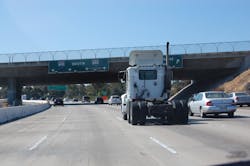Forbes magazine contributor Michele Maynard wrote an interesting story about that conundrum here, and one of the ripple effects she foresees from declining automotive use is a shift in funding from roadways to railways. We’ll see how that struggle plays out.
In terms of pure numbers, though, this decline is hard to ignore – indeed, the Energy Information Administration (EIA) noted in a recent research excerpt that “personal travel” as measured in light-duty vehicle miles traveled (VMT) per licensed driver, declined from 12,900 miles per year in 2007 to about 12,500 in 2012.
EIA’s researchers think this shift in travel behavior is important because it directly influences light-duty vehicle (LDV) energy demand for transportation fuels such as gasoline and diesel.
So what’s driving this decline in “personal travel”? The EIA points to several factors:
- Economic factors: Although economic indicators such as employment, income, and economic growth remain a dominant influence on levels of personal travel, U.S. travel indicators started to decouple from income and employment after 2007. Declines in the labor participation rate (the percentage of the total population ages 16 years and older either employed or looking for work) since the early 2000s, as well as income, fuel prices, the costs of purchasing a vehicle, and other operating costs all continue to affect LDV travel demand.
- Demographic factors: Population, age distribution, and licensing rates are important additional determinants of LDV travel demand. Licensing rates specific to gender and age groups and their associated travel behavior will affect VMT, particularly for the most influential age groups. Licensing rates for the youngest portion of the U.S. population have declined steadily since 1990 as fewer individuals obtain a driver's license or as individuals delay obtaining a license until later in life. In addition, as the population ages, individuals tend to drive less. The percentage of the U.S. population aged 65 and older is expected to increase from 17.4% in 2012 to 26.8% in 2040.
- Other contributors: Technological, social, and environmental factors also influence VMT. Increasing fuel efficiency of LDVs, telecommuting, e-commerce, urbanization, alternative modes of travel (mass transit, rail, car-sharing, car-pooling, biking, pedestrian travel), and social media can supplant or complement personal vehicle use.
So, long terms, how might such trends play out in the U.S.? If the current “low annual VMT” trend continues, the EIA expects VMT per licensed driver and total VMT to be 19% lower by 2040, with U.S. transportation sector energy demand totaling 5.3 million barrels of oil equivalent in 2040; some 18% lower than its baseline or reference case.
In the “high annual VMT” case, though, upward changes in travel behavior only result in what the agency dubs a “moderate increase” in VMT per licensed. In this scenario, VMT per licensed driver and total VMT are 6% higher in 2040 with U.S. LDVs consuming 6.7 million barrels per day of oil equivalent in 2040, or 5% more than in EIA’s baseline or reference case.
Of course, LDV fuel consumption changes affect fuel availability – and of course pricing – for commercial vehicles. So how those trends play out could affect trucking directly. We’ll see how that develops.

